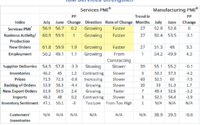People Are Paid More to Work Less. This Explains Job Shortages and Productivity – MishTalk
Expanding benefits, especially more vacation time and paid family leave, helps explain job shortages and declining productivity.

During the Pandemic, Average Hours Rose. And Fell.
The Atlanta Fed reports During the Pandemic, Average Hours Rose. And Fell.
According to payroll survey Data from the US Bureau of Labor Statistics (BLS), average weekly hours per job rose during 2020 and 2021 and have since returned to close to their pre-pandemic average levels.
However, the payroll survey’s measure of average weekly hours is an estimate of the average hours paid per job, not the hours worked per job. Looking at hours worked provides a better perspective on the supply of hours going into producing goods and services in the economy than looking at the hours paid does. To estimate average hours worked, the BLS adjusts the payroll survey’s hours-paid data to an hours-worked basis (and broadens the scope to include self-employed workers). The adjustment accounts for paid time off (sick leave, paid vacation, holidays, and family leave) as well as unpaid, off-the-clock hours worked.
This measure of average hours paints quite a different picture from the payroll survey measure: not only is it lower than average hours paid, but the gap between the two measures has grown as average hours worked has drifted lower—especially after 2015. Average weekly hours worked was 33.7 in 2006, 33.5 in 2015, and 32.8 hours in 2023. As a result, the gap between average hours paid and average hours worked has increased by almost an hour a week since 2006.
The primary driver of the divergent trends in hours paid and hours worked is the increasing prevalence of paid time off as a part of employee compensation.
A Word About Productivity
Many economists believe productivity numbers are understated. I have not been in that camp.
This data along with demographics (boomers retiring, replaced by less skilled workers demanding more benefits), explains the productivity picture.
I downloaded supplemental data to create the following chart.
Percent of Civilian Workers With Benefits

The percentage of people with paid sick leave, wellness programs, and especially paid family leave is on a tear.
The only thing declining is medical insurance, down over five percentage points since 2013.
Health Care Costs Are Soaring, So Why Does the CPI Show Falling?
In case you missed it, please note Health Care Costs Are Soaring, So Why Does the CPI Show Falling?
Hello Obamacare advocates, the decline in medical insurance should send a message about affordability.
Unfortunately, it won’t.
Job Quits by Sector in Thousands

30 Percent Raise Coming Up!
Quits rose in Leisure and Hospitality, and Accommodation and Food Service. Quits generally declined elsewhere.
The number of quits in L&H and food service is elevated. Those groups cannot work from home and will readily jump for higher wages.
For discussion please see Minimum Wage for Fast Food Workers Jumps 30% to $20 Per Hour in California
If McDonalds pays $20, why take $15.50 elsewhere?
New Corporate Ultimatum: Come to the Office in 3 Days, Quit, or Be Fired
Despite the above data, white collar employers have finally had enough with work-at-home benefits.
As noted on October 22, the New Corporate Ultimatum Is Come to the Office in 3 Days, Quit, or Be Fired
Of course, that does not apply to restaurants and the hospitality sector whose workers never had the chance to work at home.
Workers Hammered by Inflation Again as Real Earnings Sink 0.4 to 0.6 Percent
On September 13, I noted Workers Hammered by Inflation Again as Real Earnings Sink 0.4 to 0.6 Percent
I do a post like that nearly every month for years.
Regardless of whether or not increases in wages and benefits are justified, paying people more to produce less is a decline in productivity and thus inflationary.
[ad_2]
Source link


